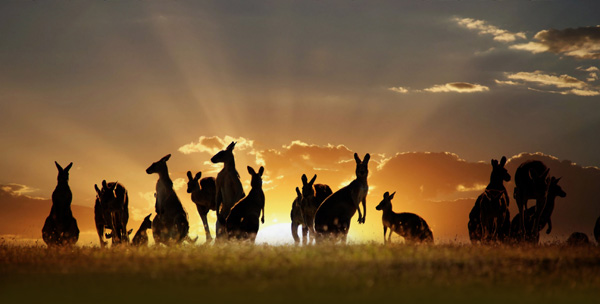Rising from the ashes of the recent downturn, Australia’s burgeoning industries represent strategic growth areas for HVACR and allied products. Industry players look at the Australian market with much hope. We bring you a special report.
Rising from the ashes of the recent downturn, Australia’s burgeoning industries represent strategic growth areas for HVACR and allied products. Industry players look at the Australian market with much hope. We bring you a special report.

Australia has certainly made its mark on the HVACR industry. One of the earliest pioneers of modern refrigeration was an Australian named James Harrison. He demonstrated and patented a commercial ice-making machine in Geelong, Victoria, in 1851. The insights he revealed and the principles he demonstrated with his early vapour-compression systems are, to this day, referenced by refrigeration manufacturers.
With many burgeoning industries, such as mining, construction and transportation, Australia is considered one of the foremost growth areas by HVACR industry players. Though market studies suggest that the Australian economy has experienced a slowdown in recent years owing to the recent global economic downturn, many HVACR companies in the country were kept afloat by local and foreign investments in the resources and infrastructure markets, as also due to a steady growth of the apartment construction sector and sizeable government spending on education- and healthcare-related infrastructure.
 Ajit Chandraraj, General Manager of AHI-Carrier, distributors of Toshiba air conditioning systems, agrees with this observation, and shares his company’s experience in Australia: “The market for residential, light-commercial and VRF units in Australia is worth approximately USD 1.25 billion, with around USD 550 million attributed to the residential sector (duct-free systems) alone.”
Ajit Chandraraj, General Manager of AHI-Carrier, distributors of Toshiba air conditioning systems, agrees with this observation, and shares his company’s experience in Australia: “The market for residential, light-commercial and VRF units in Australia is worth approximately USD 1.25 billion, with around USD 550 million attributed to the residential sector (duct-free systems) alone.”
Chandraraj, whose company has been operating in Australia since 2009, has experienced a six-fold increase in residential sales from the time they set up shop there, and a 40% increase in turnover in the first half of 2014, compared to the same period in 2013.
He, however, warns that the market has not always been this rosy. “The market was flat for three years owing to a slowdown in growth in the mining, oil & gas, hospitality and education industries,” says Chandraraj. “The situation was worsened by the government-initiated imposition of carbon tax on refrigerants used in HVAC systems.” He, however, adds that the future is not all that bleak: “After the installation of the Tony Abbott Government, there is a possibility that they will withdraw the carbon tax on a retrospective basis. If this happens, it will bode well for the HVAC industry.” (For more information on the Legislation to Repeal the Carbon Tax, see box 1).
Samuel Peli, General Manager for Sales at Seeley International, says that despite the reduction in investment and overall business confidence during the crisis years, Australia was not severely affected by the downturn. In fact, says Peli, many market experts predict a complete recovery of the Australian market by 2015.
A close look at the market
Most of the HVAC products in demand in Australia are inverter-based, and, unlike in the Middle East, the Australian market notably requires heat pump inverter products. “At Toshiba,” says Chandraraj, “our VRF systems running on all-inverter compressors allow us to meet the energy-efficiency standards and requirements in Australia.”
In terms of refrigerants, he says that Toshiba has maintained its focus on R410A, though the company is in the process of evaluating the merits of other alternatives, like R32. “Daikin and Fujitsu have gone ahead with using R32 in their products for sale in Australia, but the refrigerant is yet to gain widespread acceptance,” he says. “In fact, it is still not a prerequisite to use R32 in Australia.”
Seeley International also has its gaze trained on energy efficiency to help research and develop its latest products. “For instance,” reveals Peli, “we have developed an Air Handling Unit that uses an indirect evaporative heat transfer core that provides hyper-efficient cooling of outside air.” Peli adds that as it took his company more than a decade to develop the technology, it is confident that the product will offer exceptional cooling and energy efficiency performance.
For several years now, Australia has been employing energy efficiency regulations to pave the way for the development of less power-consuming and more cost-efficient systems. “Australia is a place where most of the products are launched, then adopted throughout the world,” says Chandraraj. “The country follows the highest MEP (minimum energy performance) standards in the world, and it is raising the bar every year, since a few years ago.” He says that MEP standards were originally only applied to wall-mounted, ducted, ceiling and cassette units. “This year, however, the authorities are contemplating and studying the inclusion of VRFs and packaged systems to the scheme of the MEP standards,” he says.
Peli adds: “MEP standards have been in place in Australia for over 10 years now. Throughout the existence of this regulation, we have noticed a 50% energy efficiency improvement among HVAC products on offer in the Australian market.”
In addition to MEP standards, Australia is also reported to be looking at implementing a Demand Response System (DRS) among residential products. “DRS,” says Chandraraj, “will allow regulators and power companies to control the operation of units from a remote location.” In response to the above-mentioned initiative, Chandraraj shares the fact that the Toshiba AC lineup for 2014 has already been equipped with DRS (for more information on DRS, see box, right).
While the country is making an aggressive push towards energy efficiency and power consumption suppression, it is also considering harnessing the potential of alternative sources of energy.
The roadmap ahead
The stringent energy efficiency and environmental stewardship regulations in Australia are challenging HVACR industry players to develop products that will satisfy the stringent requirements. While this may be daunting for some entities, HVACR manufacturers in Australia see the introduction of strict regulations as an opportunity to push the envelope of technological and methodological innovation. As Australia’s economy continues to recover from the effects of the financial correction, HVACR products that promote cost-efficiency and energy and environmental conservation are expected to enjoy higher levels of consumer demand in years to come.
| Demystifying DRS
Ajit Chandraraj shares information on the Demand Response System, which he says, may be an effective way to manage electricity demand. Highlights….“Peak demand prompted by extreme weather events result in major spikes in electricity usage. These peak events create a problem, as they require expensive investment to increase network capacity. “There are a variety of ways to respond to this problem and manage electricity demand. Demand response through direct load control may allow certain household appliances to be remotely controlled, reducing the demand for electricity at peak times. The approach would be facilitated by mandating that key appliances must be equipped with a demand response interface. This interface would allow the establishment of communication links between appliances and the electricity network. “There are different possible technologies which can allow an appliance to be remotely controlled, and currently many appliance manufacturers are unwilling to risk investing in a particular communications approach unless they know it will be used by other market participants. Mandating compliance with the Australian Standard for demand response interfaces would overcome this and allow sufficient market aggregation to occur.”
|
Copyright © 2006-2025 - CPI Industry. All rights reserved.